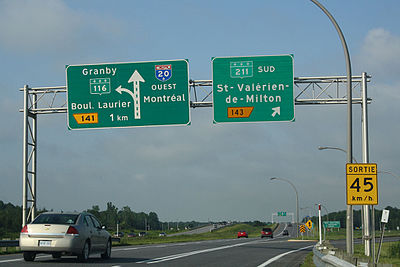Exit Info - Other languages
motorway_link tagging best practice
There are two methods to assign exit sign information into OpenStreetMap:
- The collective node and way method - the exit sign information is stored on both nodes and ways
- The node only method - all of the exit sign information is stored on a node
The preferred approach is the collective node and way method for the following technical reasons:
- It can handle complex interchanges, as where a motorway_link and its associated reference number can split multiple times (such as 3A-B-C)
- It handles turnoffs different from a country's standard without requiring tagging exceptions (e.g. a 'left' exit in right side driving countries), meaning it is easier for data consumers to be programmed for it
- Associating the exit sign information with the *_link way clarifies route guidance
- Data consumers Telenav and OsmAnd(+) both issue route guidance using node-and-way, and do not support node-only tags. A tool exists for OSRM installations to convert node-only tagging to node-and-way tagging.
node-and-way method
The exit sign information is stored on both nodes and ways as follows:
Node
| key |
value
|
| highway
|
motorway_junction
|
| ref |
<junction/exit number> OR
|
| noref
|
yes (if no reference number exists)
|
| name |
<Rarely used. Name of the indicated exit/interchange itself, not the exit's destination. Use destination tags for that, below.>
|
* junction:ref is recommended on all outbound junction points from a motorway, and should have the same value of ref=* on the node. While a node provides user-readable indicators of an exit's reference as indicated, junction:ref gracefully handles routing edge cases unambiguously, such as:
- 'left' exits in right-side-driving countries (and vice-versa)
- Nodes where multiple exit references fork away from the same node
node-only method
All of the exit sign information is stored on the node where a link splits from the motorway as follows:
Node
| key |
value
|
| highway
|
motorway_junction
|
| ref |
<junction/exit number>
|
| name |
<exit name>
|
| exit_to |
<branch route number/road name> and/or <toward route number/road name> and/or <toward location>
|
This method was popularized in the U.S. but is no longer recommended. This method is less structured than the node-and-way method and requires routers to rewrite exit_to as destination.
Definitions
Node
| Node Term |
Explanation
|
| <junction/exit number> |
The junction/exit number from the exit sign. Examples: 236, 11A, 51A-B
|
| <exit name> |
The exit name form the exit sign - this is not typical for most exits. Example from Pennsylvania Turnpike in the US: Gettysburg Pike
|
Way
| Way Term |
Explanation
|
| <toward location> |
The location(typically a city) that the exit/ramp/slip road will head toward
|
| <branch route number> |
The route number that the exit/ramp/slip road will branch onto
|
| <toward route number> |
The route number that the exit/ramp/slip road will head toward
|
| <branch road name> |
The road name that the exit/ramp/slip road will branch onto
|
| <toward road name> |
The road name that the exit/ramp/slip road will head toward
|
| <junction/exit number> |
Populate when a exit/ramp/slip road splits at a common node and has different junction/exit numbers
Example: 51A (the node <junction/exit number> will have 51A-B)
|
| <safe exit speed> |
Populate when a exit/ramp/slip road has an advisory speed sign
|
| <motorist services> |
Populate when the exit/ramp/slip road has access to services motorist need
|
Examples
Canada
Québec
United States
A/B split

Interstate 83 North ends at Interstate 81 exit sign
The above exit sign information shall be added to OpenStreetMap as follows:
Simple road name

Simple Derry Street exit sign
The above exit sign information shall be added to OpenStreetMap as follows:
Road name
This article or section may contain
out-of-date information:
Contradictory usage between two directions. If you know about the current state of affairs, please help keep everyone informed by updating this information. (
Discussion)

Interstate 695 Outer Loop at Baltimore Washington Parkway exit sign
The above exit sign information shall be added to OpenStreetMap as follows:
At the next exit, tag:
Exit name

Interstate 787 West at exit 5 sign
Exit names are usually found on toll roads. On guide signs, exit names look similar to road names. The above exit sign information shall be added to OpenStreetMap as follows:
Shared direction
This exit for northbound U.S. 67 and northbound U.S. 167 displays "North" only once, but destination:ref=* should contain "North" twice:
Shared exit
This exit serves both eastbound and westbound State Route 4:
A short distance later, the exit splits:
Subsequent node
| key |
value
|
| highway |
motorway_junction
|
| noref |
yes
|
Unnumbered exit
This exit has no visible number signage. Unnumbered exits are common on controlled-access U.S. routes and state highways in many parts of the U.S., as well as on Interstate freeways in California.
Freeway entrance
destination=* can also be tagged on an on-ramp – a highway=motorway_link way leading to a motorway:
Issues
U.S. issues
Off-ramp/on-ramp way split
When adding interchange information to ways - please review the relationship of the interchange sign information and the connected ways. Sometimes a way will need to be split between an off ramp and an on ramp. Here is an example of when interchange information was added to a way that was both an off ramp and an on ramp:
Thus, leading to the following invalid on ramp directions:

The 2nd maneuver has the invalid
on ramp instruction.
The above way was split - here is the updated off ramp way:
Here is the updated on ramp with the proper interchange information ( destination and destination:ref):
The on ramp instruction will now be: Turn left to take the I 99 North/US 220 North ramp toward Tyrone.

The 2nd maneuver has the fixed
on ramp instruction.













